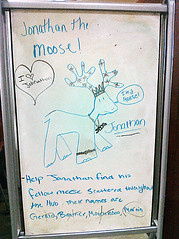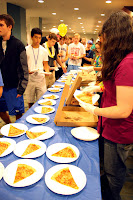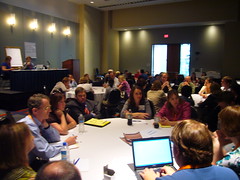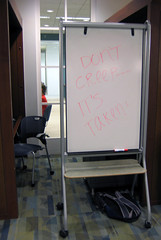Are Computer Labs Still Necessary?
Certainly this conversation is happening at more and more institutions as we look at ways to cut costs. Do we still need so many computers? Probably not, though we still need some sort of lab environment for three primary reasons:
Provide computers for students who do not have them. We make so many assumptions about our students--today's net generation is always connected, so they must all have shiny new laptops, right? While computer ownership increases each year, many of those are hand-me downs. 17.9% of students surveyed in the 2009 ECAR Study of Undergraduate Students and Information Technology own a computer that is at least four years old and around 1.5% own no computer at all. I would suspect those numbers are even higher in poorer states. Another consideration is those students who have to rely on dial-up access at home; many rural areas still aren't served with high speed access. Rather than work over a painfully slow connection, students in those areas would be more inclined to work in a campus lab. I know my step-sister would. While laptop ownership does increase each year, we continue to have other access issues.
Access to specialized software and equipment. For those connected students who own a fairly new personal laptop, it is likely that they do not have access to specialized software. Why pay for those applications if you only need them for a single class? For those students who run an alternative OS at home, they may need access to a different platform for class work. In addition to software, labs usually offer scanners and printers that students may not have access to at home. Space in a typical residence hall room is at a premium--if you own a printer and/or scanner, why would you take up precious space when you could use the shared resource in the lab? Granted, virtualization will largely solve the expensive, "I just need it for this one class" application issue, but we have to be at a point where campuses are offering a virtualized enviroment that works well and students have equipment that is robust enough to handle virtualized applications. This still doesn't address the issue of scanners and printers and other peripherals--perhaps those will remain a part of the reinvented lab space.
Convenience. If you have a short break between classes, it usually isn't worth going back to your room. This is particularly true of commuter students who often camp out for most of the day on campus. What a great opportunity to get some work done between classes--check the course management system, email, Facebook, and maybe start writing a paper or doing some library research. For those who have a laptop, who would want to lug it around all day, particularly if it is a 4+ year old brick. Even if the laptop is light, why carry it and risk theft or damage--the parents would not be happy! So enter the computer lab (and the library) for computers available for general use at students' convenience. I realize the convenience argument has less weight in these difficult budgetary times, but knowing students, I suspect it remains a much higher priority for them than we realize.
So what's the answer?
Obviously with each year, there will be fewer students who have no computing access outside of a lab. It will be a slow process to see 100% connectivity, especially in poorer states, but that doesn't prevent us from reducing the number of lab machines.
As far as specialized software, more institutions are looking toward virtualization. There are several notable virtualization projects out there already, and I expect we will see more of these in the next couple of years. I hope more institutions will put resources into this area.
So as we slowly reduce the number of lab machines, what do we do with all that space?
The Next Generation Computer Lab
I love this trend of making labs more commons-like. We've seen it at other institutions, and we have dabbled with it a bit on my campus with our "Hublets." Based on the commons concept, I see these as a few key elements of the next generation computer lab (assuming the lab isn't part of a library/commons environment already):
Relaxed food and drink policies. It has taken the library years to overcome our fear of food and drink--and many of us are not there yet--but for a space to be student-friendly, we have to be more accommodating. Is it realistic to expect someone to spend several hours in the lab without food or drink? How many hours do you spend at your own desk without food or drink? I did quite a bit of reading and talking to people about food policies before we opened the Hub, and students are generally good about being neat and reporting spills. If you don't modify those outdated policies, you won't be a student destination.
Comfort! In addition to the comforts of food and drink, students need comfortable, reconfigurable furniture. I have just completed a few student focus groups and surveys, and over and over again, students asked that chairs be comfortable enough to sit there for hours. Again, think of your own desk. Would you really sit on a pretty wooden chair all day? Of course not, yet we tend to put really uncomfortable chairs in our student spaces. You don't have to break the bank, either--I've seen several lab and commons spaces that utilized bean bags, ottomans, and pillows quite effectively (check out my pics of the Cox Computing Center at Emory, for example). Flexibility is important as well. Students are going to rearrange furniture unless it is nailed down. And if it is nailed down, students will sometimes need to gather together, so lose the idea of spacing computers only a couple of feet apart.
Fun, funky student influence. Some of the coolest labs I have seen incorporate student art, signs, or other student creativity into the space. One space even had a little ambient music going. If you want to be a destination, you have to create an inviting atmosphere. Think of the coffeehouse. The supermarket-style lighting won't cut it anymore, either.
Friendly, expert help. I still think this is the most important element. While the technology is important--particularly the specialized software and hardware that students would not have otherwise--the key to a successful space is knowledgeable, friendly experts who can provide excellent customer service. Rows and rows of computers watchdogged by sullen techies is not the image to project. When I managed desktop support, I always looked for students who had a great attitude, patience, and the willingness to teach without jargon or arrogance. The tech skills were less important.
What other elements do you see for the computer lab of the future?


















































